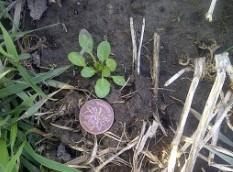by Mike Cowbrough, OMAFRA www.fieldcropnews.com
To say that March 2012 has been a record breaking month for heat is an understatement. With 11 days left to go, the Guelph area has accumulated 47 growing degree days (source: farmzone.com – base temperature of 5 degrees celsius). Compare that with last year’s frigid 4 growing degree days or the 30 year average of 19 growing degree days for the entire month of March and its no wonder that the shorts and flip flops have come out a little earlier this year. So too has weed growth in the winter wheat crop. I had a chance to walk a couple of fields yesterday and here is what I found.

Typically when growers control weeds in winter wheat it is to minimize weed seed production, to improve harvesting ease and to have cleaner straw. Since wheat can thrive in high plant density environments (we seed the crop at 1.2-1.8 million seeds after all) the yield benefit to weed removal is quite modest compared to corn or soybean.
In the above field scenario, there would be no need to spray the field right away. To begin with, there is little weed pressure, the emerged weeds are still very small and annual weeds, like common ragweed, which can cause headaches at harvest, have yet to emerge so conditions are still on the early side.
Let’s assume though, that there was heavy pressure of some of the above species and they were getting larger (5 cm or 2″ tall). What herbicides are effective?
Stinkweed: There are lots of options to control stinkweed. All of the common cereal herbicides do a good job controlling this species. However, once stinkweed starts to bolt, it becomes harder to control.
Flixweed: University of Guelph research trials have shown good control with dichlorprop/2,4-D (e.g. Estaprop XT – 95% control), MCPA Amine (90% control) and Refine SG (85% control)
Canada thistle: University of Guelph research trials have shown good control with dichlorprop/2,4-D (e.g. Estaprop XT – 87 % control), Trophy (fluroxypyr + MCPA – 85%) and MCPA Ester (83 % control). The challenge with Canada thistle is that it will continue to produce new shoots well into June, so although these products will provide good top growth control, inevitably new shoots will emerge such that at harvest time you might be hard pressed to notice any difference. This is one of the reasons why growers and crop consultants often prefer a pre harvest glyphosate application.
Burdock:If you see a burdock as shown in the above photo, do us all a favour and dig it out! Herbicide activity on burdock has traditionally been inconsistent mainly because you have plants at different stages of growth (some established 2 year plants, some seedlings). Common burdock has to be small (as shown above) for a herbicide to have any chance of controlling it. Common burdock tends to be a perimeter weed, so management is best focused around the field borders.
I have red clover!! Buctril M (bromoxynil/MCPA) is the most common herbicide used when red clover is under-seeded. In University of Guelph trials it has provided very good control of stinkweed, suppression of flixweed (70% control) and poor control of both Canada thistle and Burdock.
If you’ve taken photos with your smartphone: send them to me (if need by, I’ll identify them) and I’ll post them here to show what others are seeing in the field.
Click here to see more...